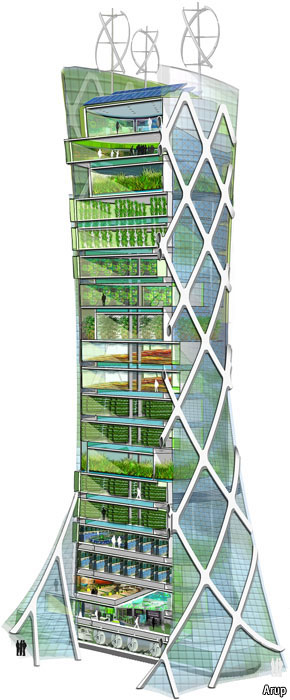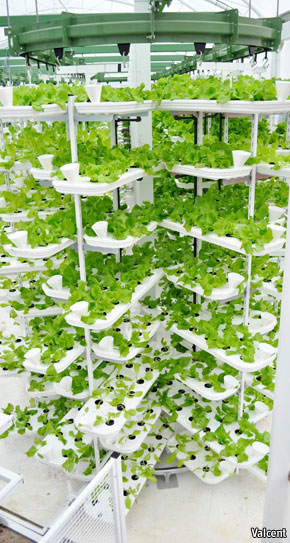-

Some researchers, such as Ted Caplow, an environmental engineer and founder of New York Sun Works, a non-profit group, argue that even using renewable energy the numbers do not add up. Between 2006 and 2009 Dr Caplow and his colleagues operated the Science Barge, a floating hydroponic greenhouse moored in Manhattan (it has since moved to Yonkers). “It was to investigate what we could do to grow food in the heart of the city with minimal resource-consumption and maximum resource-efficiency,” says Dr Caplow.
The barge used one-tenth as much water as a comparable field farm. There was no agricultural run-off, and chemical pesticides were replaced with natural predators such as ladybirds. Operating all year round, the barge could grow 20 times more than could have been produced by a field of the same size, says Dr Caplow.
Solar panels and wind turbines on the barge meant that it could produce food with near-zero net carbon emissions. But the greenhouses on the barge were only one storey high, so there was not much need for artificial lighting. As soon as you start trying to stack greenhouses on top of each other you run into problems, says Dr Caplow. Based on his experience with the Science Barge, he has devised a rule of thumb: generating enough electricity using solar panels requires an area about 20 times larger than the area being illuminated. For a skyscraper-sized hydroponic farm, that is clearly impractical. Vertical farming will work only if it makes use of natural light, Dr Caplow concludes.
One idea, developed by Valcent, a vertical-farming firm based in Texas, Vancouver and Cornwall, is to use vertically stacked hydroponic trays that move on rails, to ensure that all plants get an even amount of sunlight. The company already has a 100-square-metre working prototype at Paignton Zoo in Devon, producing rapid-cycle leaf vegetable crops, such as lettuce, for the zoo’s animals. The VerticCrop system (pictured) ensures an even distribution of light and air flow, says Dan Caiger-Smith of Valcent. Using energy equivalent to running a desktop computer for ten hours a day it can produce 500,000 lettuces a year, he says. Growing the same crop in fields would require seven times more energy and up to 20 times more land and water.
But VertiCrop uses multiple layers of stacked trays that operate within a single-storey greenhouse, where natural light enters from above, as well as from the sides. So although this boosts productivity, it doesn’t help with multi-storey vertical farms.
The Economist: Vertical Farming: Does It Really Stack Up
The article suggests that rooftop farming may be a more practical alternative in the near term. Here’s what VertiCrop looks like:

Recent Post
Read more